|
October 7, 2006
Hello from Nova Scotia: A Halifax City Tour,
Halifax' Connection with the Titanic and the 1917 Explosion
Well, in the few hours that I had spent so far in this city, Halifax
had already shown itself from its best side. After my
fairly late arrival yesterday I had a chance for a brief walk
along the waterfront before I saw an amazing performance of DRUM!
– an inspiring and heart-pumping musical kaleidoscope of Nova
Scotia’s four principal cultures: Black, Acadian, Aboriginal
and Celtic. An awesome introduction to this city….

Early morning view from my hotel
This morning I got up early since I wanted to discover the waterfront
in the daylight before joining a city tour that would give me a
good overview of what Halifax has to offer. I realized that the
batteries of my digital camera were very low and wanted to buy a
couple of replacement AA batteries, so I criss-crossed the city
from one location to another to find batteries, but to no avail.
Stores that I was directed to were either still closed or they had
just run out of batteries. Well, that meant that by 9 am I had already
spent a solid 40 minutes zig-zagging across the downtown core and
getting a bit of an overview of the central area of the city.
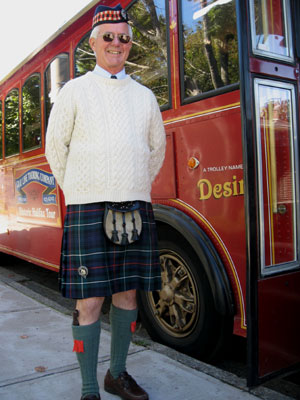
Our guide, Allen Mackenzie, beside his trolley, "A Trolley
Named Desire"
At 9 am I joined a group of tourists to go on a city tour provided
by “the Company
with the Kilts”. What makes this city tour unique is that
the historically inspired trolleys are accompanied by knowledgeable,
humorous guides that are dressed up – you guessed it –
in a kilt. On this sunny October day, our guide was Allen Mackenzie,
whose extensive historic knowledge and witty comments kept the entire
vehicle entertained.
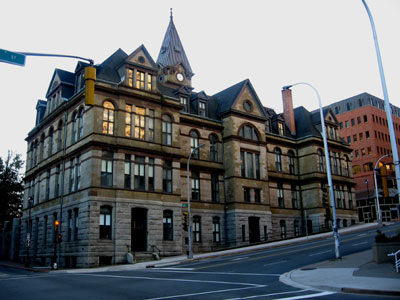
Halifax City Hall
We started along the waterfront where Allen pointed out the historic
warehouses that are part of the “Historic Properties”
complex. These warehouses used to store the loot of the privateers,
pirates that were licensed by the British Crown to raid enemy ships.
Today these former warehouses have been transformed into a series
of retail and restaurant locations while retaining their historical
appeal.
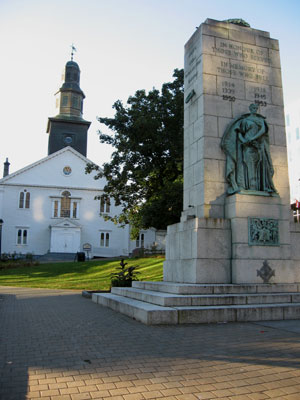
St. Paul's Church with Cenotaph in foreground
Close by is Halifax’ Casino, which Allen quite aptly referred
to as the city’s “Centre of Voluntary Taxation”.
We made our way to Grand Parade, originally a parade ground and
today a large public square which is anchored on the south side
by St. Paul's Church, Halifax’ first and oldest church dating
back to 1749 – the year the city was founded. On the north
side we saw Halifax City Hall, whose construction was started in
1887. In the centre of the Grand Parade is the Cenotaph, a war memorial
erected in 1929 that commemorates three major conflicts: the First
World War, the Second World War and the Korean War. To the west
is Citadel Hill and the Old Town Clock. One of the city’s
major landmarks, the Old Town Clock was given to the city by Prince
Edward, Duke of Kent and future father of Queen Victoria, in 1803
to ensure that all Haligonians would have a chance to be aware of
the time of day and not have an excuse for being late for work.
This treasured time piece has kept people on schedule ever since.
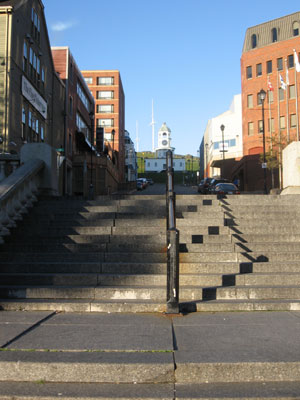
Steps leading up to the Old Town Clock
Our trolley bus snaked its way through town while Allen told us
enlightening and often humorous stories of the historic characters
that called this city home. We then drove through an area called
Spring Garden Road that has a lot of established retail shopping
opportunities before we arrived at another major Halifax attraction:
the Halifax Public Gardens. This is where we were ushered out of
the bus in order to connect with our bagpiper who would take us
on a walk through the gardens while Allen would pick us up on the
other side.
Well, as fate would have it, the bagpiper never showed up, but
Allen with his good humour took us halfway into the beautiful public
garden and asked us to all meet up on the north-west side of the
gardens where he would meet us in a few minutes with the trolley.
He also explained that the Halifax Public Gardens are the second
most renowned Victorian gardens in Canada after Butchart Gardens
in Victoria, B.C.
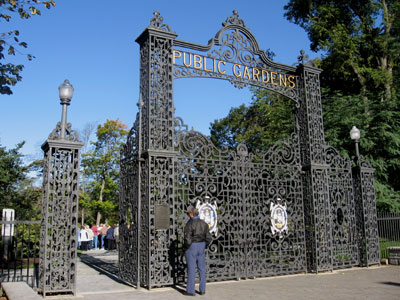
Our guide went on to explain that in order to qualify for a formal
Victorian garden, a green space would have to meet the following
requirements:
- it would have to be more than 10 acres in size
- bridges would need to be wide enough to accommodate two women
in hoop skirts, a high Victorian fashion
- the facility would need to have a bandstand, and
- two mated swans in a pond would be required to make it a true
Victorian Garden.
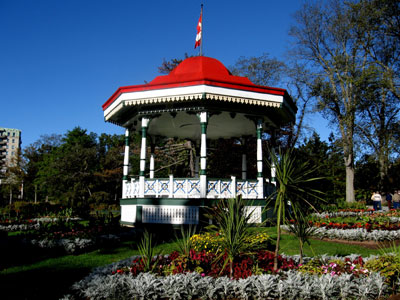
The Bandstand
He pointed out that Hurricane Juan devastated the Halifax area;
many of the old established trees in different parts of the city
including the Public Gardens were destroyed. This public garden
is a very historic place: its origins date back all the way to 1836
when the Nova Scotia Horticultural Society set out to create a public
garden that would be “accessible to all classes”. The
bandstand was erected in 1887 to commemorate Queen Victoria’s Golden Jubilee while the Jubilee (Nymph) Fountain was erected in
1897 to honour Queen Victoria’s Diamond Jubilee.
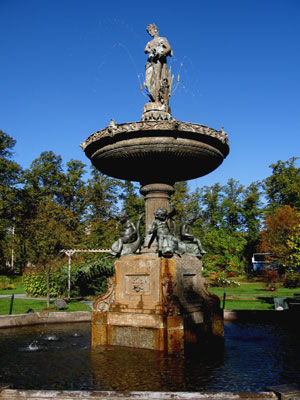
Jubilee Fountain
The pond in the heart of the gardens is called Griffin’s
Pond and was named after a young Irishman who was actually hanged
for murder on the east side of the pond in the 1830s. Allen pointed
out a miniature model of the Titanic ocean liner that was floating
on the pond which years ago was actually remote-controlled and could
be directed all over this waterway. Halifax has a huge connection
to the Titanic, as you will hear shortly.
After our 20 minute stopover at the Public Gardens we headed towards
our next stop, another place of great historical significance: the
Halifax Citadel. Again we had about 20 or 30 minutes to get out
of the bus and explore the Citadel on foot. The admission price
was included in the city
tour. The Halifax Citadel is Canada’s is one of Canada’s
most visited historic sites. Due to the strategic location of this
hill overlooking the harbour, Citadel Hill was singled out very
early on as a location for a fortress. The first fortification was
built in 1761 while the current version was completed in 1856, after
30 years of construction.
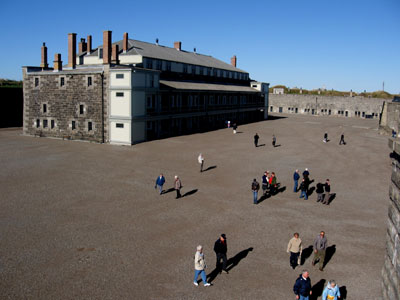
The Halifax Citadel
The Citadel is a phenomenal vantage point for overlooking the city.
The entire harbour area comes into view, and you can see all the
way across the bay to Dartmouth. Allen pointed out that the Halifax
Citadel was considered the “most terrible fortification”
in British North America, and indeed no attempts to attack it were
ever made.
Our group arrived just in time for the rifle presentation. Several
“soldiers” (in reality they are Halifax university students)
were dressed up in full historic military costumes, carrying rifles,
and our group would get an actual demonstration of a real rifle
shooting during our brief stopover. One of the young soldiers explained
that the rifles weigh 8 to 9 pounds, and with the bayonette attached
the weight goes up to about 13 pounds. He allowed me to lift the
rifle which made me realize that this was definitely not light-weight
combat. Then he proceeded to shoot the rifle several times against
the citadel’s wall, creating several loud bangs that reverberated
throughout the entire walled-in fortress.

After this quick stop we proceeded westwards through town where
Allen pointed out Dalhousie University, one of the 5 major universities
in town. We passed through a west-end neighbourhood where houses
cost somewhere between C$800,000 and C$1,500,000 according to Allen.
Our next and final stop during the tour was the Fairview Cemetery
where Halifax’ connection to the Titanic disaster became most
evident.
On the night of April 14, 1912, the Titanic, a brand-new and supposedly
“unsinkable” ship, was on its maiden voyage from Southampton,
England, to New York City. The ship, the largest and most luxurious
ocean liner of the day, was carrying about 2200 passengers and crew
when the ship collided about 11:30 pm with an iceberg. The Titanic
carried enough lifeboats for just about half the number of people
which surprisingly was in compliance with legislation in force at
that time. Many of the lifeboats were lowered into the ice-cold
Atlantic only half full, and at about 2 am in the morning of April
15, 1912, the unfathomable happened: the ship’s stern rose
up and the world’s first unsinkable ocean liner went down
into the cold depths of the North Atlantic.
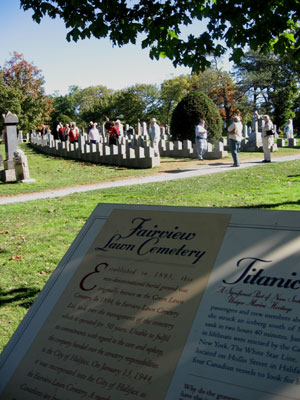
Fairview Lawn Cemetery, largest burial site of Titanic victims
Of a total of 2,223 people, only 706 survived while 1517 perished.
Some of the famous victims included John Jacob Astor IV and most
of the ship’s crew, including the entire orchestra who had
played tunes on deck until the ship’s sinking. First class
passengers had a much higher rate of survival than second and especially
third class passengers. Some of the exits from the lower decks for
the third class passengers were even locked, preventing many of
those passengers from accessing the lifeboats.
In the aftermath of the disaster, at about 4:10 am, the RMS Carpathia
picked up the first lifeboat and continued to rescue survivors.
The survivors were eventually taken to New York City while a total
of 328 bodies were eventually recovered. Many of those were taken
to Halifax where they were meticulously registered with all descriptive
features and personal possessions stored in a canvas bag. Halifax
therefore became a key location in the aftermath of the Titanic
disaster. 121 of these victims were buried at the Fairview Cemetery
while 29 other victims were buried at the Roman Catholic Mount Olivet
Cemetery and the Jewish Baron de Hirsch Cemetery.
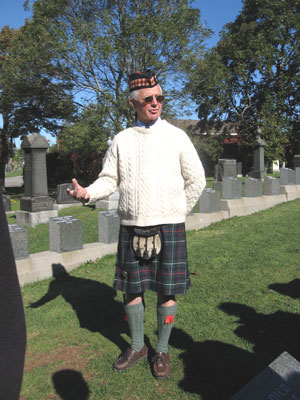
Allen explains the history of the cemetery
Our final stop on this
city tour was the Fairview Cemetery which is the largest burial
ground of Titanic victims in the world. Allen took us to a corner
of the cemetery where there were three lines of white gravestones,
all arranged in lines of different curvatures that symbolic reflect
the shape of an ocean liner on the top deck, the waterline and under
water. Allen explained that the gravestones were erected by the
White Star Line, the company that owned the Titanic.
The gravestones are very small and simple, and Allen added if people
wanted a larger gravestone they would have had to pay extra for
a larger version. He pointed out the grave of the “Unknown
Child”, the youngest victim recovered who remained unidentified.
The headstone reads “Erected to the memory of an unknown child
whose remains were recovered after the disaster of the “Titanic”
April 15th 1912”. Allen recounted various speculations that
surfaced over the years of who this unknown child might have been.
In 2002 finally it was determined through DNA evidence that the
unknown child was actually Eino Viljami Panula of Finland whose
mother and four brothers had also died in this disaster.

The grave of the unknown child
Allen also mentioned that the wreckage of the Titanic was discovered
in 1985 by an American-French expedition. The wreck had broken into
two pieces on the ocean floor, with the stern section lying about
600 m from the bow section and facing in the opposite direction.
What was really significant was that when scientists compared the
geographical orientation of one of the wrecks with the orientation
of the graves at the Fairview Cemetery, they were positioned with
almost the same geographical orientation. Hearing this sent shivers
up my spine, when I realized that the wreck of the world’s
most famous shipping disaster could coincide so accurately with
the positioning of the cemetery holding its greatest number of victims.
Things like these are almost too much of a coincidence.
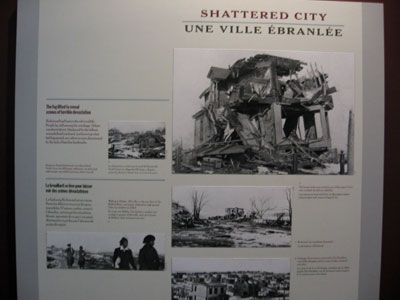
Exhibit about the 1917 Halifax Explosion in the Maritime Museum
On our way back from the cemetery, Allen enlightened us about another
Halifax disaster: the 1917 Halifax Explosion – the largest
man-made non-nuclear explosion in human history which occurred on
December 6, 1917. During the First World War many ships used Halifax
as a strategic port for their ocean voyages to Europe to partake
in the War. On this fateful day many ships were lined up in the
Bedford Basin to leave the harbour to start the voyage while other
ships were entering the harbour from the other direction.
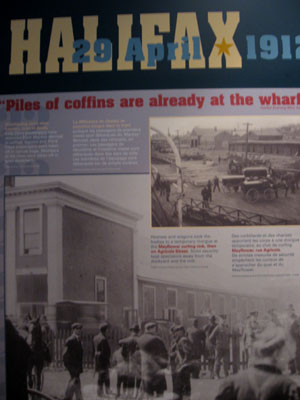
Halifax 1917: "Piles of coffins are already at the wharf"
The Mont-Blanc, a French freighter arrived at the Halifax harbour,
waiting to be let into the port. Fatefully, it was carrying thousands
of tons of explosives including benzol, nitrocellulose and TNT.
A Norwegian ship, the Imo, was trying to depart through the right
harbour channel, but another ship was blocking its way, so the Imo
veered to the left, directly into the path of the Mont Blanc. Both
ships refused to yield, leading to a collision at about 8:45 am
that ignited the benzene that was stored on deck of the Mont Blanc.
With the fire out of control and knowing their cargo, the ship’s
crew immediately abandoned the ship while hundreds of people were
drawn to the harbour to watch the fire. At about 9:04 am the Mont
Blanc finally exploded, instantly vapourizing the ship in a fireball
that rose over one mile into the air. The force of the explosion
triggered a tsunami that reached up to 18 meters above the high
water mark. The explosion could be heard as far away as Charlottetown,
Prince Edward Island, about 175 kilometers away. Not a pane of glass
was left intact in the city and 6,000 people became homeless.
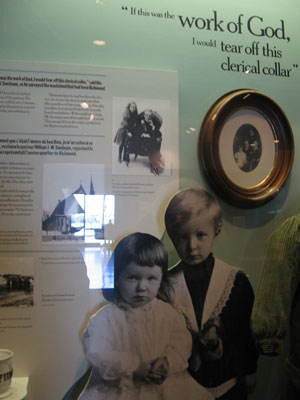
The 1917 Halifax explosion
The pressure wave from the blast could be felt as far away as Cape
Breton Island, about 205 km east of Halifax. A large portion of
Richmond, Halifax and Dartmouth were leveled to the ground, and
the death toll reached 1900 people. Thousands more were injured,
many seriously, and countless people were blinded due to the glass
shrapnel that was propelled through the air.
Allen also mentioned the story of a local hero: Vince Coleman,
a dispatcher for the Intercolonial Railway. Minutes before the explosion
he telegraphed two trains that were bound for Halifax, and told
them to stop at a safe distance from this area. Vince himself was
killed in the blast, but were it not for him, several hundreds more
could have died in the explosion.
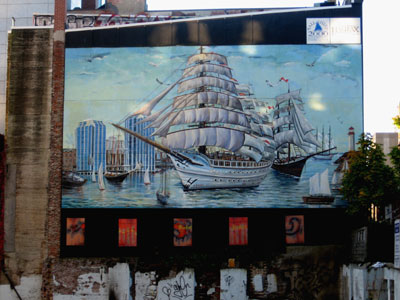
Maritime mural in Halifax
The reaction in the aftermath was swift. Communities from all over
North America pitched in and sent aid, especially tents, blankets
and supplies to Halifax. Boston, in particular, was extremely generous
and sent an entire train of supplies and medical personnel to help
the victims of this enormous explosion. As a result, every year
at Christmas, Nova Scotia donates a large Christmas tree to the
City of Boston to thank and remember Boston’s help in this
major time of need.
My trolley tour provided by the Company
with the Kilts had come to an end. But as we arrived right in
front of the Maritime
Museum of the Atlantic, I decided to make a quick stop in this
museum since among many other things, it features two major exhibits:
one about the Titanic Disaster and another one about the Halifax
Explosion. I decided to educate myself more about these two significant
historic events. The exhibit about the Halifax Explosion features
historical photographs, newspaper clippings and explanations about
this enormous disaster.
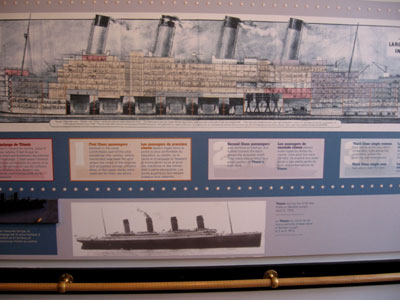
Schematic diagram of the Titanic
The Titanic Exhibit upstairs actually features dozens of photographs
and 20 authentic artifacts from the Titanic, first and foremost
the only known intact Titanic deck chair in the world. This chair
had actually been given to the minister who had performed so many
of the burials at sea and was donated by one of his grandchildren
to the Maritime
Museum of the Atlantic.
Another exhibit features the Shoes of Titanic’s Unknown Child
which feature the pencil inscription: “SS Titanic victim boots
worn by only baby drowned”. One poignant display illustrates
that fact that passenger class made a huge difference in the survival
rate of passengers. For example less than 4% of first class female
passengers perished, while around 12% of second class female passengers
died and more than 54% of third class female passenger did not survive.
I did not have time to explore the rest of the Maritime Museum
of the Atlantic which features a whole host of additional interesting
exhibits such as the Days of Sail, Shipwreck Treasures and Age of
Steam Gallery, to mention just a few. Now it was time for a quick
lunch and then my next stop at Pier
21, Canada’s immigration museum and a National Historic
Site, and the entry point form more than a million New Canadians
between 1928 and 1971.
Useful
books about travel to Nova Scotia:
Related
articles:
My five whirlwind days in Nova Scotia
Acadian
history at the Grand Pré National Historic Site
400 years of history at Annapolis
Royal
Port-Royal, a French habitation from 1605
Dinner at the Garrison House
in Annapolis Royal
The Annapolis Royal
Graveyard Tour
The Garrison House Bed and Breakfast
Exploring the Evangeline Trail from
Annapolis Royal to Yarmouth
Learning about Mi'kmaq heritage at the
Bear River First Nation Heritage and Cultural Center
Victorian heritage in Yarmouth
The MacKinnon-Cann Inn: Where Home
and Garden Television meets the Travel Channel
Yarmouth explained - the Yarmouth
County Museum
My car is in the ditch in Chebogue
River
The Lighthouse Trail from Yarmouth
to Shelburne
The Lighthouse Trail from Shelburne
to Lunenburg
The Town of Lunenburg - a UNESCO World Heritage
Site
An interview with the owners of the
Lunenburg Inn
The Lighthouse Trail from Lunenburg to
Halifax via Mahone Bay and Peggy's Cove
Arrival in Halifax and a stunning
musical performance - DRUM!
A Halifax city tour, the city's
connection to the Titantic and the 1917 Halifax Explosion
Exploring the Halifax Harbourwalk and
Pier 21 - Canada's immigration museum
A ferry trip to Dartmouth and saying
goodbye to Halifax
An interview with Pier 21 -
Canada's immigration museum
Helpful
links for travel to Nova Scotia:
Tourism
Nova Scotia
Destination
South West Nova Scotia
Halifax Tourism
|